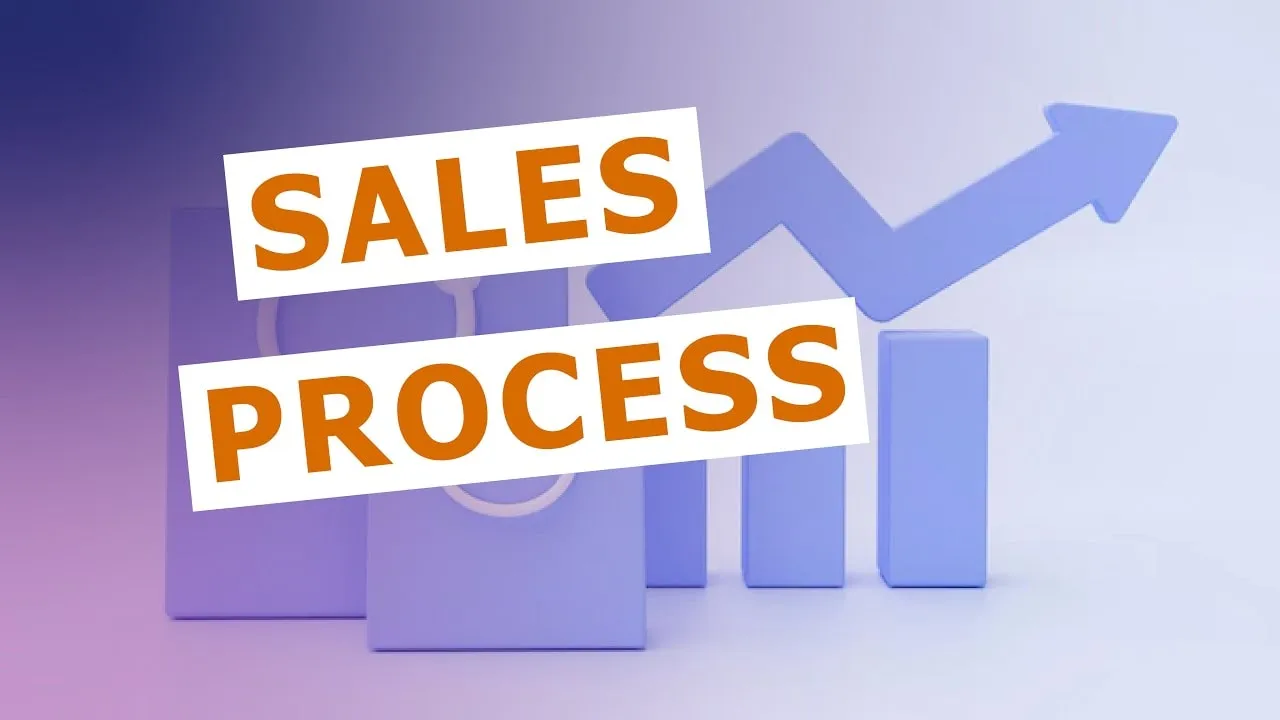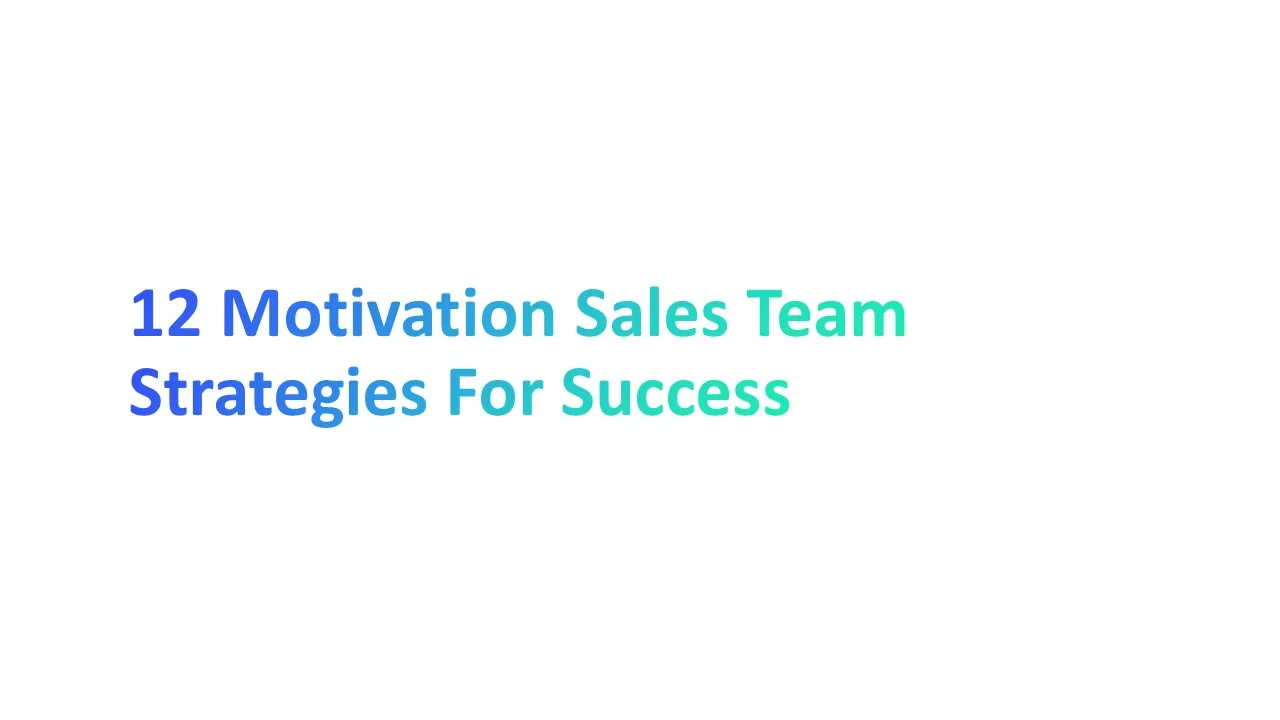Building a successful sales step process isn’t just a nice-to-have—it’s essential for closing more deals and driving growth.
Did you know that companies with a structured sales process achieve 28% higher revenue growth compared to those without? (Source: Harvard Business Review).
Whether you're an experienced sales representative or a manager leading a team of sales professionals, this guide is designed to help you develop effective strategies and actionable insights for creating a successful sales process.
From defining clear steps to leveraging advanced techniques, you'll learn how to streamline your efforts, connect with potential customers, and close deals confidently.
What is a Sales Process?

A sales process is a series of steps that help you move potential customers from interest to purchase. It provides a clear path for sales reps to follow, ensuring nothing important gets missed. Understanding the sales cycle helps sales reps identify where each potential customer stands in their buying journey.
Companies with a defined sales process see up to 28% higher revenue growth than those without one (Harvard Business Review). Let’s explore why having a unique sales process, is so important.
Why a Defined Sales Step Process Matters
1. Creates Predictability in Results
A clear sales process success makes it easier to predict sales outcomes. Sales managers can track progress and forecast their revenue generation more accurately. For example, knowing how many leads convert into buyers helps you plan for future sales.
2. Improves Team Efficiency
With a standardized sales process, every other sales manager and rep knows what to do next. This saves time and avoids confusion. Reps spend less time figuring things out and more time closing deals.
3. Enhances Collaboration Across Teams
A formal sales process ensures that your sales team and other departments, like the marketing team, work together smoothly. For instance, marketing can share data on potential prospects, helping sales reps tailor their pitches.
4. Boosts Customer Trust and Satisfaction
Customers appreciate a seamless experience. A well-organized and effective sales process makes them feel valued. From the first initial contact to the final purchase, they see you as professional and reliable.
5. Simplifies Training and Onboarding
For new sales reps, a defined process acts as a roadmap. It simplifies training by breaking tasks into clear, actionable steps. New hires can quickly learn how to handle sales calls, follow up with leads, and deliver winning pitches.
Seven-Step Sales Process: A Proven Framework

1. Initial Contact and Building Rapport
Initial contact is the first interaction between you and a potential customer. It could happen through a sales call, email, or meeting. This step is about creating a positive first impression and building trust.
Building rapport lays the foundation for a strong relationship. Studies show that buyers are 69% more likely to do business with someone they trust. (Source: Forbes) A friendly, professional start helps set the tone for the rest of the typical sales process and cycle.
How to Implement:
- Be Prepared: Research your potential customers before reaching out. Understand their business, industry, and possible challenges.
- Show Genuine Interest: Ask about their needs, goals, or challenges. Avoid jumping straight into a sales pitch.
- Use Personalization: Mention specific details about their company or role to show you’ve done your homework.
- Keep It Friendly: A warm and approachable tone helps customers feel comfortable.
For example, instead of saying, "We offer great products," try, "I noticed your company is expanding into new markets—how’s that going?"
"Experience Seamless Email Management with Alore’s Warm-Up Campaign Features."
2. Understanding Pain Points Through Active Listening
This step involves identifying the customer’s challenges, also known as pain points, by listening carefully during conversations. Active listening means focusing on their words, asking follow-up questions, and showing empathy.
Understanding pain points helps you tailor your value proposition. It shows customers you care about solving their problems, not just making a sale. This builds trust and increases the chances of successful sales.
How to Implement:
- Ask Open-Ended Questions: Questions like, “What’s your biggest challenge right now?” or “How do you feel about your current sales process?” encourage detailed responses.
- Clarify and Reflect: Repeat back what the customer says to ensure you understand. For example, “So, your main concern is finding a solution that fits your budget. Is that correct?”
- Take Notes: Document key points for later. These insights will help when crafting your sales pitch or addressing objections.
3. Crafting a Value Proposition That Resonates
A value proposition explains why your product or service is the best choice for your customers. It highlights the benefits your solution provides and how it solves their specific pain points.
Your value proposition is your first chance to stand out. According to research, 69% of customers base their buying decisions on how well a product solves their problem. A strong value proposition shows potential customers that you understand their needs.
How to Implement:
- Know Your Audience: Research your potential prospects to understand their challenges and goals.
- Focus on Benefits, Not Features: Instead of listing what your product does, explain how it makes their lives easier or more productive.
- Use Simple Language: Avoid jargon. For example, instead of saying, “We offer end-to-end solutions,” say, “We help you save time by automating tasks.”
- Be Specific: Quantify your benefits if possible. For instance, “Save 30% of your time on manual tasks with our tool.”
Imagine you’re selling a sales CRM. Instead of saying, "Our CRM is advanced," say, "Our CRM helps sales teams close deals 25% faster by tracking leads efficiently."
4. Delivering a Compelling Sales Pitch

A sales pitch is a concise presentation where you explain your product and convince your audience to take the next step. It’s your chance to make a strong impression.
A compelling sales pitch grabs attention and sparks interest. Studies show that buyers decide within the first 90 seconds if they are interested. A strong pitch makes sure they keep listening.
How to Implement:
- Start with a Hook: Open with an engaging question or fact, like, “Did you know companies with a structured sales process achieve 28% higher growth?”
- Tell a Story: Share a quick example of how your product helped another customer. For instance, “One of our clients saved $10,000 in the first month using our software.”
- Address Their Pain Points: Tie your solution back to their challenges. For example, “If tracking leads manually is slowing you down, our CRM can simplify it for you.”
- End with a Clear Call to Action (CTA): Invite them to take the next step, like scheduling a demo or asking questions. For example, “Would you like to see how this works for your team?”
"Boost Campaign Engagement with Alore’s Advanced Analytics Dashboard – Try Now!"
5. Handling Objections with Confidence
Handling objections means addressing customer concerns or doubts during a sales conversation. These objections might include questions about price, product fit, or delivery timelines.
Objections are not a bad thing—they show that the customer is interested. In fact, studies show that over 50% of buyers raise objections before making a decision. Confidently handling these challenges builds trust and demonstrates your expertise.
How to Implement:
- Actively Listen: Pay attention to what the customer is saying without interrupting. For example, if a customer says, “Your product is too expensive,” listen carefully and acknowledge their concern.
- Clarify the Concern: Ask follow-up questions to understand the root of the objection. For example, “Can you share more about your budget constraints?”
- Provide a Solution: Offer alternatives that address their concerns. If the issue is price, explain the value they’re getting for their investment. Highlight your value proposition to show how your product solves their pain points.
- Use Examples: Share success stories from other customers. For instance, “One of our clients had similar concerns but found that our product saved them $10,000 in operational costs within six months.”
By staying calm and prepared, you turn objections into opportunities to strengthen the sales process.
6. Closing the Sale with a Customized Approach
Closing the sale is the final step where the customer agrees to purchase. A customized approach means tailoring the sales methodologies for the closing strategy to fit the customer’s specific needs.
Not all customers are the same. Some need more reassurance, while others are ready to decide quickly. A personalized closing strategy increases the likelihood of a successful sale.
How to Implement:
- Recap the Value: Remind the customer how your product meets their needs. For example, “You mentioned that improving efficiency is a priority. Our solution will save your team at least 10 hours a week.”
- Ask for the Sale: Use a clear and confident call to action. For example, “Would you like to move forward today and get started?”
- Offer Flexibility: Address any last-minute hesitations by being flexible. For example, “We can adjust the payment schedule to better fit your budget.”
- Plan the Next Steps: Once they agree, outline what happens next. For instance, “I’ll send over the agreement today, and we can schedule onboarding for next week.”
Using a customized approach ensures that the customer feels confident in their decision, which builds trust and opens the door for repeat business.
7. Follow-up and Nurturing Repeat Business
The follow-up step is about checking in with your customers after the sale. This keeps the relationship alive and builds trust.
Nurturing repeat business means encouraging customers to buy from you again by providing excellent service and value.
Research shows that retaining a customer costs 5 times less than acquiring a new one. Following up shows customers you care about their experience, which increases loyalty. Happy customers are more likely to recommend your business and make repeat purchases.
How to Implement:
- Send a Thank You Note: A simple email or message shows appreciation. For example, “Thank you for choosing us! Let us know if you need anything.”
- Check In Regularly: Ask if the customer is satisfied or if they need help. For instance, “How is the product working for you so far?”
- Offer Special Deals: Give returning customers exclusive discounts to encourage repeat purchases.
- Track the Customer Journey: Use tools like a sales pipeline to stay updated on where they are in the process.
- Use Branded Gifts: Sending promotional items like mugs, pens, or custom branded tote bags not only delights customers but also keeps your brand visible in their daily lives, encouraging loyalty and repeat business.
By maintaining contact and offering value, you strengthen relationships and turn one-time buyers into loyal, repeat customers.
"Transform Your Email Strategy Today! Start Automating with Alore's Drip Campaigner."
The Role of Sales Reps in the Process

1. Bridge Between Prospects and the Company
Sales reps serve as the primary point of contact for potential customers and target companies. They are the link between what the company offers and what the customer needs. Their job is to explain the product or service clearly while building trust.
How to Do It:
Active Listening: Listen carefully to understand the customer’s concerns and goals. Ask questions like, “What challenges are you facing?”
Clear Communication: Share information about the product or service in simple terms. Avoid jargon and keep the conversation relatable.
Build Relationships: Focus on creating trust. Use follow-ups and personalized communication to show that you care about their success.
For example, when a prospect mentions they need better efficiency, the sales rep can explain how the company’s tool saves time and enhances productivity.
2. Tailoring Solutions to Customer Needs
Every customer has unique needs. Sales reps customize their pitch to show potential client how the product or service addresses specific pain points.
How to Do It:
Research the Customer: Learn about the customer’s industry, business size, and goals. This information helps make the pitch relevant.
Highlight Value Propositions: Explain exactly how the product benefits the customer. For instance, “Our software will reduce your manual tasks by 30%.”
Offer Flexible Options: Be ready to adapt. If a customer mentions budget concerns, offer payment plans or alternatives to fit their needs.
By understanding the customer, sales reps ensure the product feels like the perfect fit.
3. Maintaining Momentum in the Sales Pipeline
Sales reps keep the sales process moving by following up with potential customers and addressing their needs at each stage of sales funnel. This ensures no opportunity is lost.
How to Do It:
Track Progress Regularly: Use tools like a sales pipeline to see where each prospect is in various steps of the sales process. For example, check if they need follow-ups after a sales call.
Set Clear Goals: Break the sales process into stages with deadlines. This keeps both sales professional the rep and the buyer personas of the customer on track.
Follow Up Consistently: Reach out to ensure prospects stay interested. For example, send updates, helpful articles, or product information.
Sales reps who stay organized and proactive help close deals faster and keep the sales team aligned.
"Never Miss a Lead Again. Alore Keeps Your Pipeline Active and Your Deals Moving."
4. Providing Insights for Continuous Improvement
Sales reps gather feedback from prospects and customers. They share this information with the team to improve the company’s strategies and solutions.
How to Do It:
Ask for Feedback: After a sale or interaction, ask the customer what worked well and what didn’t. For example, “What part of the process could we improve?”
Analyze Pain Points: Share common challenges customers face with the sales managers or the marketing team. This can help refine pitches and create better offers.
Use Data: Track customer behavior, such as responses to emails or demo participation. Use this data to suggest improvements to the sales process.
When the sales leaders and reps provide insights, the entire team benefits. It leads to better sales tools, smoother processes, and more successful sales.
Best Practices for Creating Sales Processes

1. Map the Buyer’s Journey First
Mapping the buyer’s journey means understanding every step your potential customers take before they make a purchase. This includes how they discover your product, evaluate it, and decide to buy.
Sales process mapping provides a visual layout of each stage, helping teams pinpoint where leads may drop off.
When you know your customer’s journey, you can align your sales processes with their needs. This ensures your efforts meet them at the right time with the right message.
A mapped sales journey also improves communication across your sales team and ensures everyone works towards the same goal.
How to Implement:
- Research Your Target Audience: Use data from sales reps and the marketing team to learn about your customers’ challenges and goals.
- Identify Key Stages: Break the journey into stages like awareness, consideration, and decision.
- Document the Journey: Create a visual map or chart that outlines these stages.
- Match Sales Actions: Align each stage with actions like sending emails, making calls, or offering demos.
For example, if a buyer is in the "consideration" stage, your sales pitch should focus on showcasing benefits and value.
2. Involve Cross-Functional Teams
Cross-functional teamwork means including people from different departments, like marketing, product, and customer success, in the creation of your sales process.
Collaboration ensures the process covers all aspects of the customer journey. It also brings in diverse perspectives, making your sales step process more comprehensive.
For instance, the customer journey might include feedback loops from customer success teams or insights from marketing campaigns.
How to Implement:
- Set Up Regular Meetings: Schedule discussions with representatives from marketing, product, and sales.
- Share Data and Insights: Use information from each team to identify gaps in the current sales process steps.
- Define Roles Clearly: Ensure each team knows its role in supporting the process.
- Test and Improve: Gather feedback from these teams after implementing the process to make adjustments.
For example, marketing can provide insights into market segments and the value proposition that resonates most, while product teams can share features customers find most useful.
3. Define Clear Stages with Specific Goals
Every sales process has stages, like initial contact, lead qualification, and closing the sale. Defining these sales stages more clearly means identifying what needs to happen at each step. Each stage should have specific goals, such as moving a lead to the next stage or closing the deal.
Clear stages help sales reps and the sales team stay focused. It ensures that everyone knows what actions to take and when to take them.
This approach improves efficiency, reduces confusion, and keeps your sales pipeline moving smoothly. It also helps your team achieve successful sales more consistently.
How to Implement:
- Identify Stages: Break your sales process steps into clear phases, such as lead generation, product presentation, and follow-up.
- Set Goals for Each Stage: For example, in the "presentation stage," the goal might be to deliver a strong sales pitch that highlights your product’s value.
- Document the Process: Use tools like a sales playbook to provide step-by-step guidance for each stage.
- Train Your Team: Make sure every sales rep understands the stages and their role in meeting each goal.
This clarity ensures no leads are left behind and helps your team deliver customer success consistently.
4. Leverage Automation for Repetitive Tasks
Automation uses tools and software to handle repetitive tasks like sending follow-up emails, scheduling meetings, and updating lead information in your sales pipeline.
Automation saves time for sales reps, allowing them to focus on more meaningful tasks, like building relationships with potential customers.
It also ensures consistency in communication and reduces the risk of human error. For example, automated follow-ups can increase response rates without burdening the sales team.
How to Implement:
- Identify Repetitive Tasks: Look for tasks your team does often, such as logging activities or sending reminders.
- Choose Automation Tools: Tools like CRM software can automate tasks and provide insights into the customer journey.
- Integrate with Your Workflow: Ensure the tools fit seamlessly into your sales step process to avoid disruption.
- Monitor and Adjust: Regularly review how automation impacts your sales processes and make changes as needed.
For instance, if your team spends hours on manual data entry, automation can free up time for activities like crafting personalized value propositions.
"Simplify Complex Campaigns with Alore's Integration Tools – Start Your Free Trial!"
5. Regularly Review and Optimize
Regularly reviewing your sales process step by step to ensure it stays effective. The target market also changes constantly, and your sales process must adapt to stay relevant.
Reviewing helps you identify weak points in your current sales process. It highlights areas where sales reps face challenges, such as handling objections or following up effectively.
Regular optimization can improve customer satisfaction, improve successful sales, and help your sales team achieve their goals faster.
How to Implement:
- Gather Feedback: Ask your sales reps and sales managers about their daily challenges. Understand pain points and potential improvements.
- Analyze Data: Look at key metrics like follow-up times, sales pipeline conversions, and customer success rates.
- Test New Strategies: Try adjustments, such as refining sales pitches or updating value propositions, to see what works best.
- Track Results: Compare new results with your previous performance to confirm improvements.
By reviewing your own sales strategy and process regularly, you ensure long-term success for your sales team and better results for your potential customers. Sales process management ensures each step is optimized, helping teams achieve consistent results.
"Stay Ahead in Sales! Use Alore to Optimize Your Sales Process in Real-Time."
Advanced Techniques for a Sales Rep to Improve Sales Process

1. Leverage Data-Driven Personalization
Data-driven personalization is about using customer information to make companies create more tailored experiences. A sales rep can analyze data like buying history, preferences, or online behavior to offer specific solutions.
Personalized communication increases trust. Customers feel understood and are more likely to engage. According to a study by Epsilon, 80% of consumers are more likely to buy when brands offer personalized experiences.
How to implement:
- Use CRM tools to gather customer data, such as preferences or previous interactions.
- Segment potential customers into groups based on shared traits.
- Personalize emails or pitches by referencing specific customer needs.
- Regularly update customer profiles with new data to refine personalization.
2. Adopt Multi-Channel Outreach
Multi-channel outreach means connecting with potential customers across various platforms like email, social media, phone calls, or direct messaging.
Different customers prefer different communication channels. Using multiple channels increases the chances of reaching them effectively. Research by HubSpot shows companies using multiple channels achieve 80% higher response rates.
How to implement:
- Identify where your target audience spends time. For example, some industries favor LinkedIn while others are active on Instagram.
- Combine outreach strategies like email marketing with social media messages or phone follow-ups.
- Track the performance of each channel. If emails work best for one group, prioritize that channel.
- Ensure consistent messaging across platforms to avoid confusing potential customers.
3. Master the Art of Active Listening
Active listening means fully focusing on what the customer is saying without interrupting. It involves asking clarifying questions and summarizing to ensure understanding.
Customers want to feel heard. Active listening helps you identify pain points and potential needs. This builds trust and increases the chance of closing a deal. According to HubSpot, sales reps who practice active listening see 17% higher conversion rates.
How to implement:
- Stay focused: Avoid distractions and listen closely when the customer speaks.
- Ask open-ended questions: For example, "What challenges are you facing in your current process?"
- Summarize: Repeat back key points to show you understand. For instance, “So, you’re looking for a solution that simplifies your sales pipeline, correct?”
- Take notes: Write down important details to refer to later during follow-ups.
- Show empathy: Respond in a way that validates their concerns, such as saying, "I understand how that could be frustrating."
4. Implement Strategic Follow-Ups

A strategic follow-up is a planned way to reconnect with potential customers after the initial contact. It keeps the conversation going and reminds them of the value you offer.
Follow-ups ensure that customers don’t forget about your solution. A study by InsideSales shows that 50% of sales happen after the fifth follow-up, but most sales reps stop after one or two attempts.
How to implement:
- Create a schedule: Use CRM tools to plan follow-ups at regular intervals.
- Customize your message: Refer back to previous conversations. For example, “Last time we spoke, you mentioned needing better tools for your sales team.”
- Use multiple channels: Follow up via email, phone calls, or even social media messages, depending on the customer’s preference.
- Offer new value: Share a resource like a case study or article that relates to their pain points.
- Track your results: Record each follow-up and its outcome. This helps you refine your approach over time.
5. Utilize Social Selling Techniques
Social selling is using social media platforms like LinkedIn and Twitter to connect with potential customers. It’s about building relationships and sharing valuable content instead of pushing sales directly.
Customers today spend a lot of time online. They research products and compare options. Social selling helps you meet them where they are. It builds trust and keeps you top-of-mind when they’re ready to buy.
How to Implement It:
- Build Your Profile: Make sure your LinkedIn or other professional profiles are complete and appealing. Add a professional photo and showcase your experience.
- Connect with Potential Customers: Use tools like LinkedIn’s Sales Navigator to find and engage with decision-makers. Send personalized messages to start a conversation.
- Share Relevant Content: Post articles, videos, and insights that solve customer problems. Make your posts about them, not you.
- Engage with Comments: Reply to comments and questions on your posts. This shows you care and encourages more interaction.
6. Analyze and Refine the Sales Pipeline
A sales pipeline is the path your leads follow to become customers. It includes stages of sales conversations like initial contact, follow-ups, and closing the sale.
A clean and efficient sales pipeline helps you track progress and spot problems early. It ensures no potential customer slips through the cracks.
How to Implement It:
- Review Each Stage: Check how long leads stay in each stage. If they’re stuck, figure out why. Are you missing follow-ups or offering unclear value?
- Identify Drop-Offs: Look for points where leads drop out of the process. Adjust your approach at these stages. For example, use reminders for follow-ups or improve your sales pitch.
- Use Automation Tools: Automate repetitive tasks like sending reminders or scheduling meetings. Tools like HubSpot or Salesforce make this easy.
- Measure Success: Track metrics like conversion rates and deal sizes. Use this data to set better goals and refine your strategy.
7. Practice Consultative Selling
Consultative selling focuses on understanding the customer's needs. Instead of just pitching your product, you act as a trusted advisor.
You ask questions, listen actively, and offer solutions that truly fit the customer’s pain points. This technique builds trust and long-term relationships.
Customers today expect more than just a sales pitch. They want value. By practicing consultative selling, you show that you care about their challenges.
This approach not only increases sales success but also helps sales organization gain repeat business and referrals. It is a critical step in your sales methodology and improving your sales process.
How to Implement:
- Research Your Customer: Learn about their industry, challenges, and goals. Use tools like CRM systems or market research to gather insights.
- Ask Open-Ended Questions: Encourage the customer to share their needs. Questions like, “What challenges are you facing in your current process?” can reveal valuable information.
- Listen Actively: Pay attention to what they say. Use their words to tailor your recommendations.
- Focus on Value: Highlight how your product or service solves their specific problems. Use case studies or customer testimonials to support your points.
- Follow Up Strategically: After offering a solution, check back to ensure it meets their needs. This shows you’re invested in their success.
Common Sales Process Mistakes to Avoid

1. Misaligning with Potential Prospects
One common mistake in the sales step process is failing to align with the needs of potential prospects. This happens when sales reps focus more on their pitch and less on understanding the customer's unique challenges. Misalignment leads to a lack of trust and missed opportunities.
How to avoid it:
- Research your audience: Study your potential prospects. Understand their industry, pain points, and needs.
- Ask the right questions: During the initial contact, engage them in meaningful conversations. This builds trust and provides insights into their priorities.
- Use data tools: Tools like CRMs can help sales reps track customer behavior and preferences. This makes personalization easier.
2. Ignoring the Importance of Sales Presentation Preparation
Another frequent mistake is neglecting proper preparation for sales presentations. A poorly prepared presentation can hurt your credibility and ruin a promising opportunity.
How to avoid it:
- Understand your audience: Before the presentation, research the customer’s needs. Focus on how your solution can solve their problems.
- Practice your delivery: Rehearse your sales pitch to ensure clarity and confidence. Use visuals to make your points more engaging.
- Be ready for questions: Anticipate potential objections and prepare thoughtful responses.
3. Not Training the Sales Team for Objection Handling
Handling objections is a critical part of the sales step process. Objections come in many forms—pricing, timing, or product fit. If your sales team is not trained, they may lose potential customers.
How to Train Your Team:
- Role-Playing: Practice common objections like "too expensive" or "not the right time."
- Scripts: Provide simple scripts for tricky situations.
- Feedback: Review calls to help sales reps improve.
By preparing your team, you can ensure they handle objections confidently and professionally.
4. Overlooking Follow-Up Opportunities
Many sales processes fail because follow-ups are missed. Some prospects need reminders to make a decision.
How to Implement:
- Schedule Reminders: Use CRM tools to track follow-ups.
- Personalize Your Approach: Mention past discussions or their needs.
- Use Multiple Channels: Email, phone calls, or even social media can help you stay connected.
Following up regularly keeps your sales pipeline active and helps build lasting relationships.
"Your Sales Success Story Starts Here! Try Alore for Hassle-Free Campaign Management."
Conclusion
The sales step process is essential for guiding your team toward successful sales. By avoiding common mistakes, such as skipping follow-ups or neglecting objection handling, you can refine your sales process.
Train your sales reps effectively and focus on building meaningful connections with potential customers. A strong process ensures smoother sales operations, better results, and long-term customer success.

.webp)







